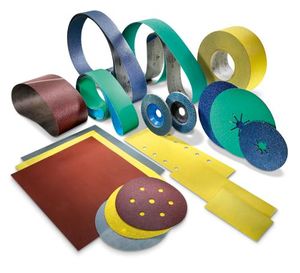Abrasives: Difference between revisions
From DT Online
m (Added category links) |
(Added Safety Point) |
||
| (4 intermediate revisions by the same user not shown) | |||
| Line 1: | Line 1: | ||
[[File:Abrasives.jpg|300px|right]] | [[File:Abrasives.jpg|300px|right]] | ||
__TOC__ | |||
=====Description===== | |||
[http://en.wikipedia.org/wiki/Abrasive '''Abrasive papers'''] and cloths are used for finishing wood metal and plastics. Various abrasive grits, including emery, garnet, sandstone, glass powder and silicon carbide, are graded by passing through sieves. The [http://en.wikipedia.org/wiki/Sandpaper#Grit_sizes '''grit size'''] is given as the sieve mesh size per inch - low numbers for coarse and high for fine. | [http://en.wikipedia.org/wiki/Abrasive '''Abrasive papers'''] and cloths are used for finishing wood metal and plastics. Various abrasive grits, including emery, garnet, sandstone, glass powder and silicon carbide, are graded by passing through sieves. The [http://en.wikipedia.org/wiki/Sandpaper#Grit_sizes '''grit size'''] is given as the sieve mesh size per inch - low numbers for coarse and high for fine. | ||
Commonly used types | |||
=====Commonly used types:===== | |||
{| | {| | ||
|- | |- | ||
| Line 16: | Line 23: | ||
---- | ---- | ||
<span style="color: green">'''Note:''' | <span style="color: green">'''Note:''' | ||
When working through the grades of abrasives to achieve a fine finish, always try to work across scratches left by the previous grade. When sanding wood this may also mean working at alternate diagonals to the | When working through the grades of abrasives to achieve a fine finish, always try to work across scratches left by the previous grade. When sanding wood this may also mean working at alternate diagonals to the [https://en.wikipedia.org/wiki/Wood_grain '''Grain'''] and finishing last of all with the grain. ''(To understand this, think that a river running through a valley may make it more rounded, but it deepens it : it does not remove it!)'' | ||
</span> | </span> | ||
<span style="color: green"> | <span style="color: green"> | ||
When finishing flat surfaces, and especially edges, it is best to support the paper or cloth in some way - for example: glass paper can be wrapped around a cork sanding block; wet or dry paper may by fixed to a piece of waterproof | When finishing flat surfaces, and especially edges, it is best to support the paper or cloth in some way - for example: glass paper can be wrapped around a cork sanding block; wet or dry paper may by fixed to a piece of waterproof '''[[Manufactured Board|Ply]]''' and emery cloth may be wrapped around a file ''(also oil may be added to emery cloth to improve the final finish)''. | ||
</span> | </span> | ||
---- | ---- | ||
| Line 27: | Line 34: | ||
[http://en.wikipedia.org/wiki/Flapwheel '''Flap Wheels'''] and [http://en.wikipedia.org/wiki/Flapwheel '''Flap Discs'''] comprise multiple overlapping small pieces or ''flaps'' and are used for metal finishing. | [http://en.wikipedia.org/wiki/Flapwheel '''Flap Wheels'''] and [http://en.wikipedia.org/wiki/Flapwheel '''Flap Discs'''] comprise multiple overlapping small pieces or ''flaps'' and are used for metal finishing. | ||
---- | |||
<span style="color: red">'''Safety Point!''' | |||
To avoid the danger of severe cuts to your fingers, do not pull off pieces of steel wool with your bare hands but cut with '''[[Scissors]]''' and wear gloves. Highly inflammable. Keep dry and away from any source of electrical current or naked flame. | |||
</span> | |||
---- | |||
{{Abrasives Buyers Guide}} | |||
[[Category:Primary]] | [[Category:Primary]] | ||
[[Category:Secondary]] | [[Category:Secondary]] | ||
[[Category:Tools | [[Category:Shaping, Abrading and Finishing Tools]] | ||
Latest revision as of 08:37, 11 October 2016
Description
Abrasive papers and cloths are used for finishing wood metal and plastics. Various abrasive grits, including emery, garnet, sandstone, glass powder and silicon carbide, are graded by passing through sieves. The grit size is given as the sieve mesh size per inch - low numbers for coarse and high for fine.
Commonly used types:
| Sandpaper, Glasspaper and Garnet papers |
- used dry mainly for sanding of wood and coarse grades can be used also for paint removal. |
| Silicon Carbide | - commonly known as ‘wet or dry paper’ and used for general finishing of metals and plastics |
| Emery Cloth | - used dry principally to polish metals - especially steel. |
Note: When working through the grades of abrasives to achieve a fine finish, always try to work across scratches left by the previous grade. When sanding wood this may also mean working at alternate diagonals to the Grain and finishing last of all with the grain. (To understand this, think that a river running through a valley may make it more rounded, but it deepens it : it does not remove it!)
When finishing flat surfaces, and especially edges, it is best to support the paper or cloth in some way - for example: glass paper can be wrapped around a cork sanding block; wet or dry paper may by fixed to a piece of waterproof Ply and emery cloth may be wrapped around a file (also oil may be added to emery cloth to improve the final finish).
Fine Steel Wool can also be used to produce a finish on metals or loaded with beeswax to cut back varnish on wood. Liquid cutting compounds and metal polishes are also mild abrasives, as are Pumice and Jewellers' Rouge.
Flap Wheels and Flap Discs comprise multiple overlapping small pieces or flaps and are used for metal finishing.
Safety Point! To avoid the danger of severe cuts to your fingers, do not pull off pieces of steel wool with your bare hands but cut with Scissors and wear gloves. Highly inflammable. Keep dry and away from any source of electrical current or naked flame.










